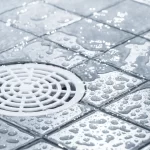Pipes are at the very heart of the plumbing trade, and as a result there are a lot of different materials we use when installing plumbing systems. Today’s post is going to explain the different materials used, and what their applications are, as well as advantages and disadvantages. We will also discuss some older materials no longer used or being phased out (see National Plumbing Code of Canada for more info). So without, further ado, we’ll start with copper, as it is the most common.
Copper Pipes
Copper pipes have been used in plumbing for a very long time. To this day, copper is still the most commonly used material in clean water supply lines. Copper is inherently tolerant of a huge range of temperature changes, from freezing cold to very hot.
There are two main types of copper pipe: flexible, and rigid. The names pretty much describe the difference between the two. Rigid pipes are often used during construction to run supply and drainage lines. Flexible copper is often used for making repairs to a building.
These pipes come in different sizes, specified by a letter designator, and ranging from . K is the largest and thickest of the copper pipes, while L is a medium size and M is the smallest and thinnest.
One disadvantage to using copper, which results in plumbing contractors using copper more than DIY weekend warriors, is that you must heat up the pipe (usually using a propane torch) and use lead-free solder and flux.
CPVC, PVC, ABS, and PEX Pipes
These are plastic pipe types used for many different plumbing applications.
CPVC pipes are cheaper and easier to install than copper, but they are less durable in comparison. You can tell them from PVC in that they are usually cream-colored. CPVC comes in a huge range of sizes, and is great for running clean water lines. They do not corrode or combust, and are easily installed by newbies. To install a CPVC pipe, just cut the pipe, debur it (smooth out the edges), and apply CPVC primer to clean the pipe. Use CPVC cement to fit the pipe.
PVC pipes are white, while ABS are black. These are a lightweight pipe and are not recommended for much of anything anymore, though they are still commonly used for drain pipes. The problem with these pipes is exactly that they are lightweight, so they do not handle hot temperatures well. PVC and ABS can burst or explode when put under pressure and heated.
PEX (cross-linked polyethylene) is a new-comer to the pipe scene. It is an extremely durable material, withstanding temperatures from below freezing to extremely hot. PEX is designed for interior and underground installations.
Materials No Longer in Use
Before the 20th century, lead piping was commonly used in plumbing, dating back to the Roman empire, which used lead pipes for its supply and drainage lines. Of course, now we know that lead is toxic and it has long since been phased out by galvanized steel and copper in plumbing.
Galvanized steel is a cheap and strong form of steel, and has been used in many industries. It is still used a bit today in plumbing, but is mostly being phased out in favor of better metals. One problem with galvanized steel is that it does not mix well with other types of metal such as copper or brass, as it causes an electrolytic process. This type of steel can also contain lead, making it toxic and a bad choice for clean water supply lines. It is, however, extremely resistant to heat and flame, and is still used in some cases.
Clay pipes were used in plumbing until around the 1950s. While not a terrible material to use, the problem with clay is that it can easily collapse, or succumb to tree root infestation. The good news is, if you have clay pipe, you can replace it by using pipe bursting, or even reline it with a new no-dig drain liner.






